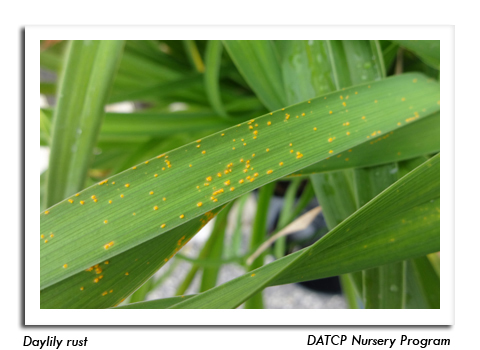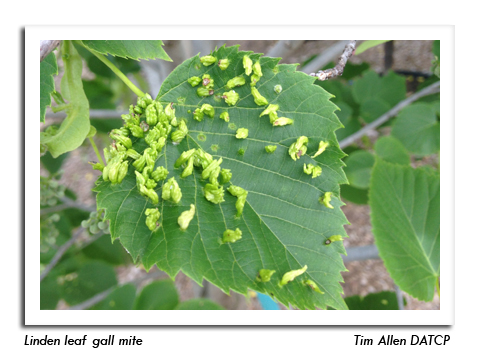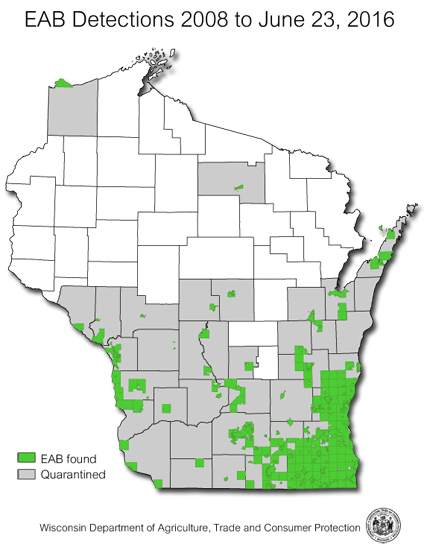
 |
|
|
Nursery & Forest
Volume 61 Number 9 Date 06/23/2016 DAYLILY RUST - The daylily varieties 'Aztec Priestess' and 'Royal Frosting' in a Kenosha County garden center are developing this rust disease. The most recognizable symptom is the long, brownish-yellow streaks which develop along the leaves. As the disease progresses, small, raised yellowish-orange pustules appear on the leaf undersides. These pustules eventually release orange spores that are wind-dispersed to other daylilies. The disease cycle involves a secondary host, Patrina spp. Daylily rust is not known to overwinter in Wisconsin. The spores arrive on southerly winds or on infected daylilies from out-of-state suppliers. IMPATIENS DOWNY MILDEW - This destructive foliar disease of impatiens was found in a Kenosha County garden center last week. In 2012, impatiens downy mildew (IDM) became widespread in U.S. greenhouses and landscape settings, with Wisconsin and more than 30 other states reporting cases. Young impatiens plants are especially susceptible to infection and symptoms are often first observed on terminal growth. IDM thrives in humid, cool conditions and is capable of causing complete defoliation and plant collapse. Commercial growers of impatiens are advised to inspect and cull plants with light green stippled leaves, curled leaves, or the characteristic white, downy mycelia growth on the undersides of foliage. Home gardeners should also carefully examine impatiens for IDM symptoms before purchasing flowers, and consider planting the mildew-resistant New Guinea impatiens or a New Guinea hybrid to avoid losing plants to IDM. COTTONY MAPLE SCALE - The white, cottony egg masses produced by this pest of deciduous trees and shrubs were observed on red maple and 'Autumn Splendor' horse chestnut trees at a nursery in Dunn County. Cottony maple scale is generally considered only a nuisance pest, as populations are cyclical and peak every few years, causing significant branch and twig dieback when levels are high. Chemical treatments directed against the crawler stage should be considered only after two consecutive years of heavy infestation. Light infestations may be pruned out and destroyed. APPLE SCAB - Ornamental crabapple trees in Dunn and Washington counties were expressing light to moderate leaf spotting symptoms associated with this fungal disease. Infected leaves initially develop brown or olive lesions that later turn black. These primary spring infections produce secondary spores which continue to infect leaves and fruits during wet periods throughout the growing season, often resulting in severe defoliation. Cultural practices such as pruning, planting resistant varieties, thorough sanitation, and careful watering can usually control apple scab. Fallen leaves should be removed in autumn to reduce the amount of inoculum available to start the infection cycle the following year. Fungicides are generally not warranted for nursery stock, except in years when the disease is particularly severe. -- Ellen Natzke, DATCP Nursery Inspector LINDEN LEAF GALL MITE - The distinctive nail-shaped galls caused by this mite are appearing on lindens in Oneida County. The galls are the result of early-spring feeding by the overwintered mites that passed the winter on sheltered parts of the tree. At this time of season the galls are greenish yellow, but eventually turn reddish-brown. LLGM specializes on plants in the genus Tilia and occurs on littleleaf linden and basswood trees. The galls usually form on the shaded, lower leaves and are mostly a cosmetic problem. -- Tim Allen, DATCP Nursery Inspector EMERALD ASH BORER - Juneau County has been added to the growing list of Wisconsin counties with confirmed EAB infestations, after the June 15 detection of EAB near Lyndon Station. The metallic green beetles began emerging from infested ash trees by June 10 and were observed in Racine County on June 17 and Fond du Lac County on June 19. Beetle emergence usually begins around 450 growing degree days (modified base 50°F) and peaks at or above 1,000 growing degree days. New EAB detections in the past week include the following three municipalities, all located in counties with known EAB populations: Jefferson County (City of Jefferson), Vernon County (Village of Stoddard), and Waukesha County (Village of Butler). -- Renee Pinski, DATCP Forest Entomologist 





|
|
|